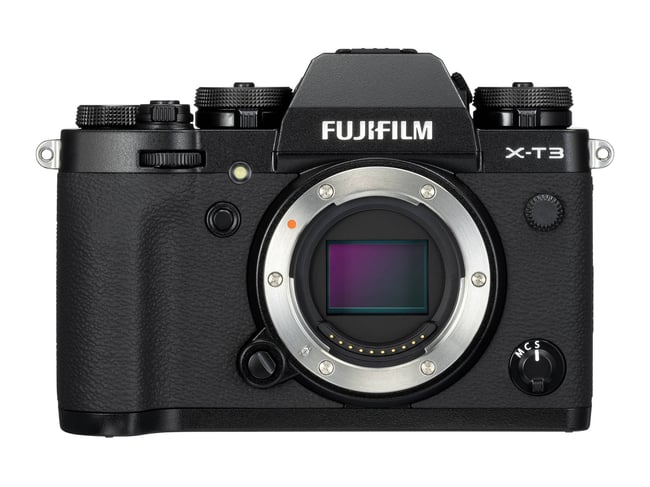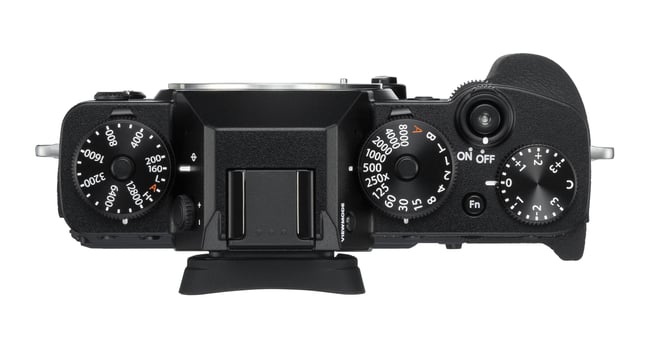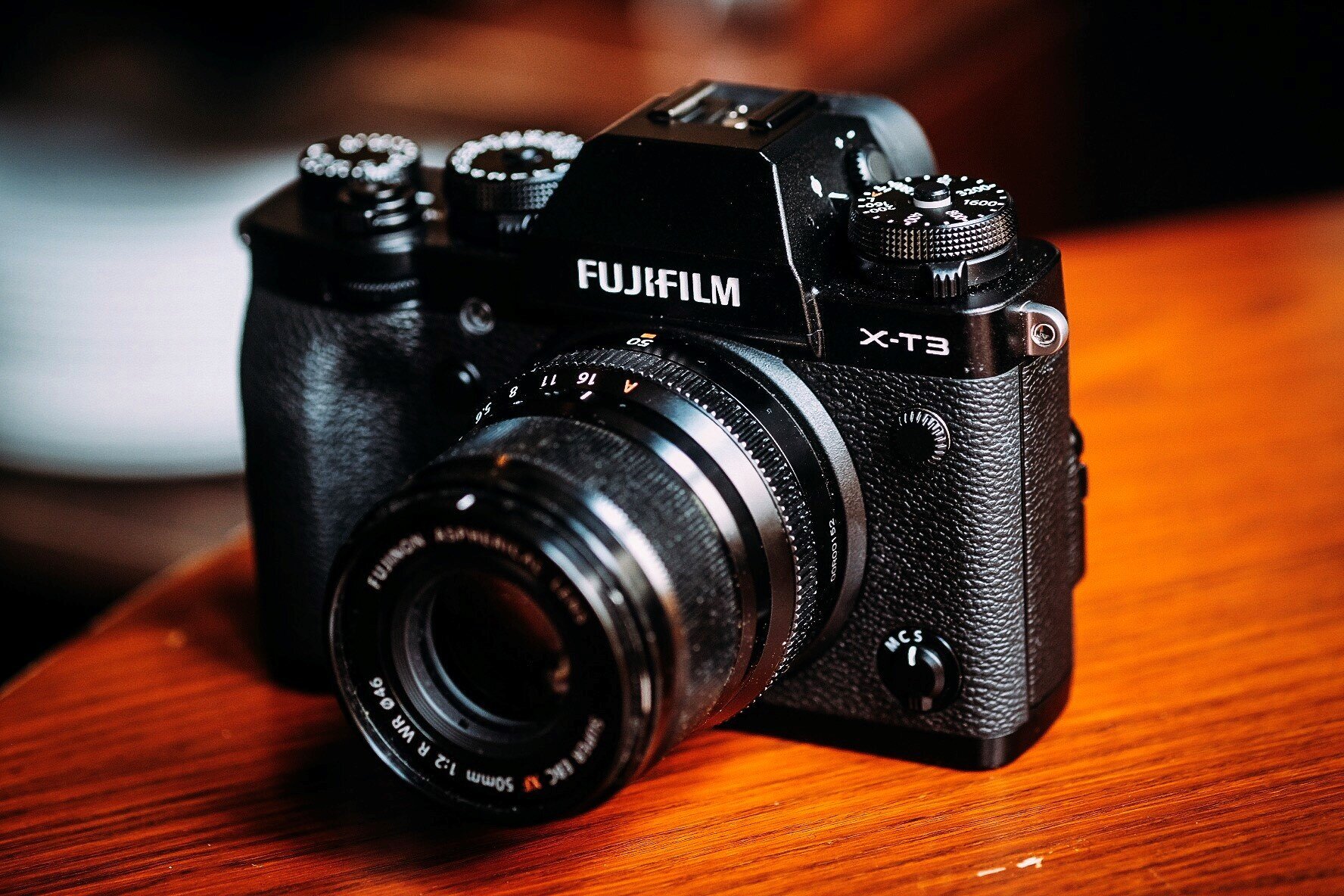As the third iteration of the X-T series cameras, the Fuji X-T3 is the most advanced and refined camera. Sporting a fast quad-core processor capable of recording high-quality 4K videos, a high-resolution 26.1 MP APS-C X-Trans BSI CMOS sensor, a fast and accurate autofocus system, and superb ergonomics, the X-T3 has become a very popular camera among photographers. Despite its many strengths, the X-T3 has plenty of controls and menu options that can be confusing for beginner photographers. In this article, I’ll go through most of the camera controls, as well as the menu system, which will hopefully help our readers in understanding the camera a little better.
Controls and Handling
Similar to its predecessors, the X-T3 has a number of dials, buttons, and controls that perform different functions. Let’s go through each one of them, one at a time, starting from the front of the camera.
Front of Camera
Below is an overview of all the controls from left to right around the mount, as well as the front dial:

- Front Command Dial: Can control certain settings depending on how you’ve set up the camera. For example, in the Set Up Menu, set “ISO Dial Setting (A)” to “Command” (Set Up -> Button/Dial Setting) and you can use this command dial to change your ISO settings any time you have the top ISO dial set to A (Auto).
- Lamp: AF-Assist Illuminator shines light when there is not enough ambient light for focusing, or when self-timer is engaged.
- Function Button (Fn2): Customizable. I keep it at default “Drive” value.
- Lens Release Button: Hold the button and rotate the lens to detach it.
- M/C/S Switch:
- Sync Terminal: For connecting external flash units.
Top of Camera
Next, we will go over the top of the camera, from left to right:

- ISO Setting / Drive Dial: Rotate this dial to change your ISO. By default, I keep it at “A” for Auto ISO. Once you choose a value, you can press the button on the top to lock it. The bottom of the dial allows changing the camera Drive.
- Diopter Adjustment Control: Adjust diopter to make viewfinder clearer and tailored to your eyes.
- View Mode Button: For switching between EVF and LCD. You can disable the viewfinder entirely, or enable it exclusively (disabling the rear LCD). You can also set it to detect your eye, switching between the rear LCD and the viewfinder when you look through the viewfinder, or disabling the rear LCD entirely and only turning on the viewfinder when you look through it. I set mine to Eye Sensor + LCD Image Disp, so that the camera automatically switches between EVF and LCD.
- Shutter Speed / Metering Dial: Use this dial to change your shutter speed. Set it to “T” and use the rear command dial if you prefer adjusting shutter speed that way. I typically set mine to “A” and set aperture through the lens, in order to shoot in Aperture Priority mode. For metering, I keep mine set to “Multi” by default, but depending on what I am shooting I also use “Spot” metering sometimes.
Back of Camera
Lastly, let’s review the back of the camera, once again from left to right:

- Trash Button: Deletes images
- Review Button: Plays back your images
- AE-L: This button can be programmed under “Function (Fn) Setting” in the Set Up menu (Set Up -> Button/Dial Setting). By default, holding it down locks exposure. I prefer changing the menu option “AE/AF-L Lock Mode” to “AE&AF On/Off Switch”, so that simply pressing the AE-L button locks autofocus, without having to continue to hold it.
- Rear Command Dial: Can serve a number of functions, including changing shutter speed if you have the top shutter speed dial set to T. You can also scroll this wheel to change the size of your autofocus zone once you press in the joystick. And in playback mode, push in this dial to instantly jump to magnified view. Note that due to a design flaw on Fuji cameras, you need to be shooting RAW + JPEG rather than just RAW if you want to magnify your photos to 100% in playback mode.
- AF-L Button: This button by default is used for locking autofocus, but it can be customized to perform back-button focusing, which is what I have set up on mine.
- Q button: Pops up a quick menu where you can change some common settings. You can adjust your personal Q menu in the “Edit/Save Quick Menu” setting in the X-T3’s Set Up menu.
- Joystick: This is how you move autofocus points. Press in the joystick and rotate the rear command dial to change the size of your autofocus zone.
Fuji X-T3 Camera Settings
Now that we went through all the essential buttons and dials, it is time to take a deeper dive into the camera menu in order to set it up optimally. Please keep in mind that these recommendations are not a one-size-fits-all answer. It’s intended to set you on the right path, but there is a reason why Fuji has so many options here – everyone’s needs are different. So, feel free to take these as a starting point, but don’t be afraid to pick different settings for yourself as needed.
Image Quality Setting
- Image Size: Grayed-out (because of shooting RAW); when shooting JPEG pick “L 3:2” for maximum size
- Image Quality: RAW
- RAW Recording: Lossless Compressed
- Film Simulation: Standard (doesn’t affect RAW photo)
- B&W Adj: Default
- Grain Effect: Off (doesn’t affect RAW photo)
- Color Chrome Effect: Off (doesn’t affect RAW photo)
- White Balance: Auto (doesn’t affect RAW photo)
- Dynamic Range: DR 100% (doesn’t affect RAW photo)
AF/MF Setting
- Focus Area: Shows all focus points and lets you select yours, akin to pressing in the joystick. Turn the rear dial to change the size of your focusing zone.
- AF Mode: Single Point, since it gives you the finest control for focusing in most cases. If you want to track subjects, it is best to use Wide/Tracking and then enable continuous autofocus via the switch on the left of the camera. To track subjects across a smaller portion of the frame, but not just a single point, use Zone and change its size to suit your needs by pressing in the joystick and then turning the rear dial to change the size of your focusing zone.
- AF-C Custom Settings: The default value of 1 (Multi Purpose) works well for most subjects. Depending on what you are shooting, you might want to adjust this setting.
- Store AF Mode by Orientation: For storing focus points differently when shooting vertical vs horizontal. I set mine to “On”.
- AF Point Display: This only matters when you are in Zone or Wide/Tracking AF Modes, not Single Point. It simply shows your focusing points, which some photographers will find helpful and others distracting. I leave mine Off.
- Number of Focus Points: 425 (only available in Single Point) since it gives you the most control. Some prefer 117 simply because you can switch between them faster, since fewer focus points are available.
- Pre-AF: This is continuous autofocus, prior to taking the photo, on the point you select. Its goal is not to track your subject, but to make it faster to autofocus when you actually want to capture a photo, since your focusing is already close to optimal. However, it can be quite spastic and distracting, so I tend to leave it off.
Shooting Setting Menu
- Drive Setting: Choose from different drive settings and customize them. I personally set my Bracketing Setting for the following: Bkt Select -> AE Bkt. AE Bkt -> 3 Frames, 1 EV Step. Sequence Setting -> “- 0 +”
- Sports Finder Mode: Off. Use this for shooting fast action. It enables 1.25x crop (shows the crop frame in the viewfinder) and allows capturing images with zero blackouts.
- Pre-Shot ES: Off. When shooting action, the camera will start capturing images when the shutter release is half-pressed. I would recommend keeping this turned off unless you are shooting something critical.
- Self-Timer: Off for taking photos without a delay, 2 seconds for tripod-based landscape work, 10 seconds when you need to run in front of the camera and join a group photo
- Interval Timer Shooting: For taking time-lapses. It lets you select the interval between shots and the total number of photos.
- Shutter Type: E-Front + Mechanical + Electronic. The camera automatically switches between different shutter types depending on the shutter speed.
Flash Setting Menu
- Flash Function Setting: Main flash control. Off when you don’t need flash, typically TTL when you do (through-the-lens automatic flash).
- TTL Mode: TTL
- Zoom: Grayed Out
- Sync: Fire the flash at the beginning of your exposure (1st Curtain) or at the end (2nd Curtain). When photographing moving objects, you generally will want to change Sync Mode to be 2nd Curtain to capture the motion of the subject before the flash properly – the blur leading into a sharp subject.
- Angle: Grayed Out
- Red Eye Removal: Off
- TTL-Lock Mode: TTL Lock gives you a consistent flash exposure across several images when enabled (which must be done via a custom function button you assign). This chooses whether the exposure is locked at the prior metered exposure or by metering via a set of pre-flashes.
- LED Light Setting: Lets you use the video light on your flash to act as a focus assist beam and/or a catchlight. Keep it off unless you have a need for either of those features. Grayed out except with external flash.
Movie Setting Menu
- Movie Mode: 4K 23.98P
- H.265(HEVC)/H.264: H.265(HEVC)
- Movie Compression: Long GOP
- Full HD High Speed Rec: 5x 23.98P
- Film Simulation: Standard
- B&W Adj: Default
- White Balance: Auto
- Dynamic Range: DR 100%
- Highlight Tone: 0
- Shadow Tone: 0
- Color: 0
- Sharpness: 0
- Noise Reduction: 0
Set Up Menu
- User Setting
- Format: To format your memory card
- Date/Time: To change the camera’s internal clock
- Time Difference: To tell the X-T3 when you are in a different time zone and adjust the internal clock accordingly
- Language: Select default language
- My Menu Settings: Add, rank, and remove items from your “My Menu” – very useful
- Sound Set-Up
- AF Beep Vol: Off
- Self-Timer Beep Vol: Off
- Operation Vol: Off
- Shutter Volume: Off if you want only noises from the mechanical shutter. For 100% silent operation, turn this off and enable electronic shutter only (from “Shutter Type” under the Shooting Setting menu). If it’s disconcerting to hear no noise at all while taking pictures with the electronic shutter, such as when looking through the optical viewfinder, turn the volume to low.
- Screen Set-Up
- EVF Brightness: 0
- EVF Color: 0
- EVF Color Adjustment: Default
- LCD Brightness: 0
- LCD Color: 0
- LCD Color Adjustment: Default
- Image Disp: How long your photo pops up on the rear screen or electronic viewfinder after capture. Set it to “Off” if you don’t want any display at all, and 0.5, 1.5, or Continuous if you want some length of post-capture image display.
- Button/Dial Setting
- Focus Lever Setting: Affects whether moving the joystick changes autofocus points. When set to Lock, you can’t move autofocus points with the joystick at all. Set to “Push Joystick to Unlock,” you can only start moving your autofocus points when you push in the joystick once. Set to On, you move autofocus points any time you move the joystick. I keep it On.
- Edit/Save Quick Menu: A very useful option to adjust the layout and content of the Quick Menu (accessed by pressing the Q button). Change this to suit your shooting style and most frequently accessed controls.
- Function (Fn) Setting: Lets you assign custom functions to six FN buttons, AE-L, AF-L, as well as touch controls and the rear dial. This is down to personal preference, but it is a good way to access settings you use all the time without entering a menu. Here is what I set to mine, in order: Fn1 (AF Mode), Fn2 (Drive), Fn3 (Shutter Type), Fn4 (ISO Auto Setting), Fn5 (Face/Eye Detection Setting), Fn6 (Preview Depth of Field), T-Fn1 (Histogram), T-Fn2 (Performance), T-Fn3 (Natural Live View), T-Fn4 (Electronic Level), AE-L (AE-L), AF-L (AF-ON), R-Dial (Focus Check).
- Power Management
- Auto Power Off: 2 Min (personal preference)
- Performance: Normal
- Save Data Set-Up
- Frame Number: Continuous. If you select Renew, the camera will begin file names from 0001 each time you format your memory card or insert a new one, resulting in more photos with duplicate names
- Save Org Image: Off. When On, saves two copies of a photo when redeye reduction is enabled (one without the reduction applied). No other effect on your photos.
- Edit File Name: You can give your photos custom file names to start the image, such as FUJ_0001. I customize this for each camera I own in order to reduce duplicate file names from multiple cameras. The X-T3 lets you choose different file names for sRGB and Adobe RGB images.
- Card Slot Setting (Still Image): Sequential.
- Select Slot (Stills Sequential): 1
- Select Slot (Movie Sequential): 1
- Select Folder: Don’t Change
- Copyright info: Fill in your information in case you lose your camera or it gets stolen.
I hope you find the recommended settings above useful for setting up your Fuji X-T3. If you have any questions about the information in this guide, feel free to ask below. Please keep in mind that most of these settings are personal preferences, and it is not a problem if your own preferences are different; after all, Fuji included all these options for a reason, and not everyone will set up their camera the same way.
